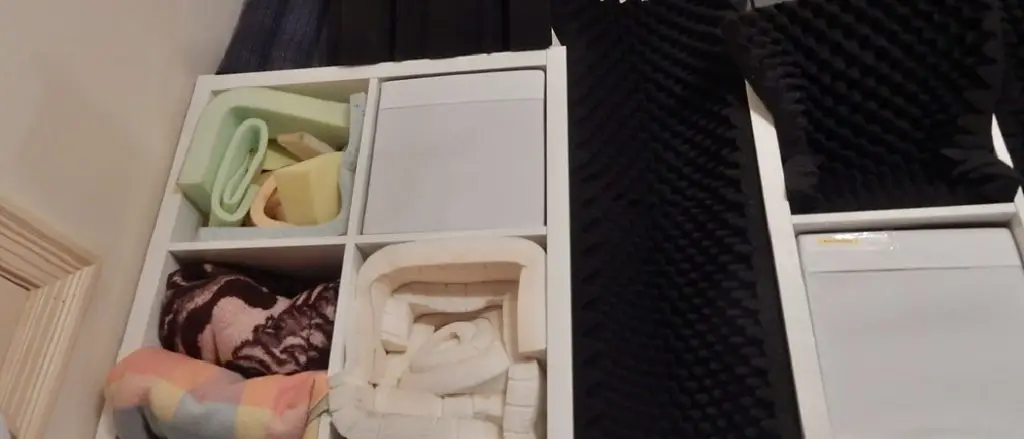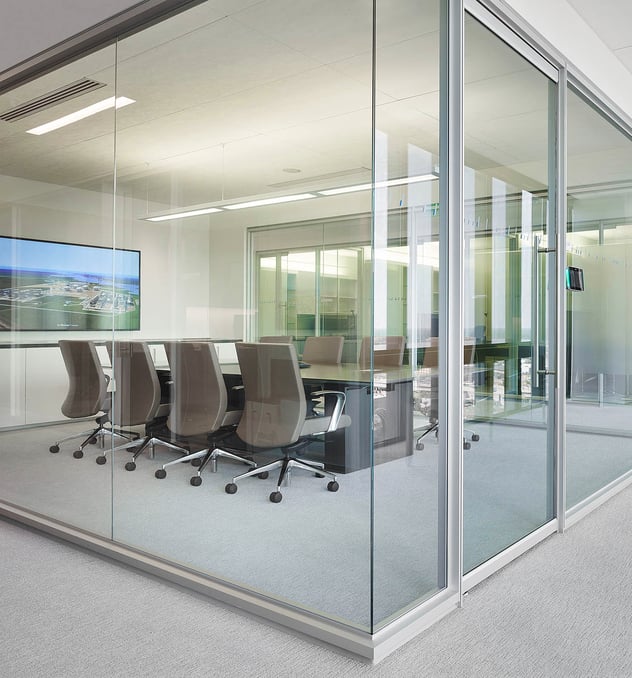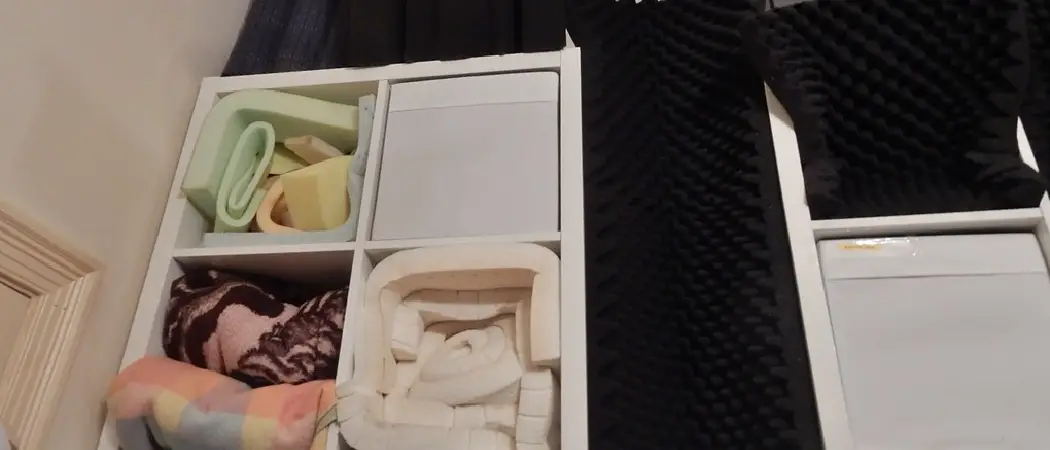To soundproof a wall, use acoustic panels or foam mats for best results. Seal any gaps or cracks with caulk.
Looking to reduce noise disturbances in a room? Soundproofing a wall can be a great solution. Whether you want to create a quiet environment for better focus or simply minimize noise transfer between rooms, soundproofing can make a significant difference.
By implementing effective soundproofing techniques, you can enjoy a more peaceful and comfortable space. We will explore simple and practical methods to soundproof a wall effectively. Whether you are working from home, recording music, or simply seeking a more serene living space, soundproofing can help you achieve the desired level of tranquility. Let’s delve into the process and explore how you can effectively soundproof a wall in your home or workspace.

The Importance Of Soundproofing
When it comes to creating a peaceful and comfortable environment in your home or workplace, soundproofing is of utmost importance. Understanding the impact of noise pollution and the benefits of soundproofing a wall can help you appreciate the value it brings to your space.
Understanding The Impact Of Noise Pollution
Noise pollution can have significant adverse effects on our wellbeing and quality of life. Unwanted noise can disrupt our concentration, cause stress and anxiety, and affect our sleep patterns. Whether it’s street traffic, construction activities, or noisy neighbors, excessive noise can be a serious nuisance that hampers our ability to relax, work, or rest.
In addition to the psychological impact, noise pollution can also have physical consequences, such as increased blood pressure, heart problems, and impaired cognitive development, especially in children. Therefore, taking measures to soundproof your walls can help mitigate these negative effects and create a serene environment.
Benefits Of Soundproofing A Wall
Soundproofing your walls offers a myriad of advantages that go beyond reducing noise disturbances. Let’s explore some of the key benefits:
- Enhanced Privacy: By minimizing sound transmission, soundproofing provides the privacy you need, preventing conversations or activities from being overheard by others. This is especially crucial in office settings or multi-family residences where privacy is highly valued.
- Improved Sleep Quality: Soundproofing your bedroom walls can create a tranquil environment, free from outside noises that disturb your sleep. By blocking unwanted sound, you can enjoy a restful night’s sleep, waking up refreshed and ready to face the day.
- Increased Productivity: Whether you work from home or have a home office, soundproofing the walls can significantly improve your focus and productivity. By reducing distractions and minimizing noise interruptions, you can concentrate better on tasks and accomplish more in less time.
- Enhanced Acoustics: If you are a music enthusiast or have a home recording studio, soundproofing the walls can help create an optimal acoustic environment. By preventing sound from escaping or entering the room, you can enjoy better sound quality while minimizing disturbances for others.
Investing in soundproofing your walls is a valuable investment in your overall well-being and quality of life. By understanding the impact of noise pollution and the benefits of soundproofing, you can create a peaceful and comfortable space that promotes relaxation, focus, and restful sleep.
Assessing The Wall
Assessing the Wall:
Identifying The Problem Areas
Look for cracks, gaps, and weak spots in the wall that may allow sound to leak through.
Evaluating The Sound Transmission Class (stc) Rating
Measure the STC rating to determine how much sound is being transmitted through the wall.
“`
In the process of soundproofing a wall, assessing the wall is the crucial first step.
Identify cracks, gaps, and weak spots that may allow sound to penetrate.
Also, evaluate the Sound Transmission Class (STC) rating to assess sound transmission levels.
Determining Soundproofing Techniques
Determining the right soundproofing techniques is crucial for effectively soundproofing a wall.
When choosing the right materials and methods, it’s important to consider various factors such as the level of noise, the construction of the wall, and the desired outcome.
Choosing The Right Materials
Mass Loaded Vinyl (MLV): This dense and flexible material effectively blocks and absorbs sound, making it ideal for soundproofing walls. It can be installed by hanging it like wallpaper or by sandwiching it between layers of drywall.
Soundproof Drywall: Offering enhanced soundproofing properties compared to regular drywall, soundproof drywall is a simple and effective solution for reducing noise transmission through walls.
Understanding Acoustic Caulk And Putty Pads
Acoustic Caulk: This specialized sealant is designed to fill gaps and cracks in walls, ceilings, and floors, preventing sound leakage. It is an essential component for ensuring airtight seals in soundproofing projects.
Putty Pads: These self-adhesive pads are used to dampen vibrations and reduce sound transmission through electrical outlets and light switches, contributing to overall soundproofing efforts.
Exploring Mass Loaded Vinyl (mlv)
Benefits of MLV: MLV offers high mass and flexibility, allowing it to effectively block airborne noise while conforming to uneven surfaces. It is a versatile soundproofing solution suitable for various wall constructions.
Considering Soundproof Drywall
Enhanced Soundproofing: Soundproof drywall contains viscoelastic polymers and other sound-dampening materials, providing increased noise reduction compared to traditional drywall. Its installation is similar to standard drywall, making it a convenient option for soundproofing walls.
Insulating With Acoustic Foam Panels
Acoustic Performance: Acoustic foam panels are designed to absorb and diffuse sound waves, reducing echo and reverberation within a space. When strategically placed on walls, they can contribute to sound insulation and improve overall acoustics.

Soundproofing Methods
When it comes to soundproofing a wall, there are several effective methods you can use to reduce noise transmission. Here are some commonly used soundproofing techniques:
Use Of Double Drywall
Installing double layers of drywall can help improve sound insulation in your walls. The added mass of the second layer can absorb more sound vibrations, reducing noise transmission.
Applying Green Glue Compound
Applying Green Glue compound between drywall layers can dampen sound waves and enhance soundproofing. This viscoelastic material converts sound energy into heat, reducing noise transfer.
Staggering Studs And Joists
Staggering studs and joists helps prevent sound vibrations from traveling through the structure of the wall. This disrupts the path of sound waves, minimizing noise transmission.
Sealing Gaps And Cracks
Sealing any gaps and cracks in the wall with acoustic caulking or sealant can prevent air leaks and reduce noise infiltration. Proper sealing ensures a tight barrier against sound.
Tips For Effective Soundproofing
When it comes to soundproofing a wall, there are various effective tips that can help minimize noise transmission and create a quieter environment. By implementing these soundproofing techniques, you can significantly reduce the impact of external noise and improve the overall acoustic insulation of your space.
Minimizing Vibrations
To effectively soundproof a wall, it’s important to minimize vibrations that could transmit and amplify noise. Using soundproofing materials such as resilient channels and mass-loaded vinyl can help dampen vibrations and prevent them from traveling through the wall.
Using Sound Absorbing Curtains
Another effective method for soundproofing a wall is to utilize sound absorbing curtains. These curtains are designed to absorb and block sound waves, reducing the level of noise that enters or exits the room. By hanging sound absorbing curtains over windows or doors, you can create a barrier that helps minimize sound transmission.
Strategically Placing Furniture And Decor
Strategic placement of furniture and decor can also contribute to soundproofing a wall. Heavy and dense furniture items, such as bookshelves or sofas, can act as sound barriers and help reduce noise transmission. Additionally, adding decorative elements such as tapestries or wall art can help dampen sound reflections and improve acoustic insulation.
Optimizing Room Layout
The layout of the room plays a significant role in soundproofing. Strategically positioning furniture and fixtures can help create barriers that block or absorb sound. By optimizing the room layout, you can minimize the impact of noise transmission and enhance the overall acoustics of the space.
Managing Door And Window Sound Leakage
Doors and windows are common areas where sound leakage can occur. To address this, sealing gaps around doors and windows with weatherstripping can help prevent sound from seeping through. Additionally, installing acoustic door sweeps and double-pane windows can further improve sound insulation.

Diy Vs. Hiring Professionals
When soundproofing a wall, considering the pros and cons of DIY methods versus hiring professionals is essential. While DIY options like using soundproofing panels or insulation can be cost-effective, professionals can ensure a more effective and lasting solution through their expertise and specialized equipment.
Benefits And Limitations Of Diy Soundproofing
When it comes to soundproofing a wall, you have two options: doing it yourself (DIY) or hiring professionals. While DIY soundproofing can be a cost-effective solution for some, it’s important to understand the benefits and limitations before making a decision.
Benefits:
1. Cost savings: DIY soundproofing can save you money as you won’t have to pay for professional labor. You can choose affordable materials and perform the installation yourself.
2. Flexibility: With DIY, you have the freedom to customize your soundproofing solution based on your specific needs. You can experiment with different techniques and materials to achieve the desired results.
3. Learning experience: Taking on a DIY project allows you to acquire new skills and knowledge. You can gain a sense of accomplishment by successfully completing the project on your own.
Limitations:
1. Time-consuming: DIY soundproofing can be time-consuming, especially if you lack experience. Extensive research, planning, and the actual installation process may take longer than expected.
2. Skill requirements: Certain soundproofing techniques may require specialized skills and tools. If you’re not familiar with the process or don’t have the necessary expertise, it can be challenging to achieve optimal results.
3. Potential mistakes: Without professional guidance, there is a higher risk of making mistakes during the DIY soundproofing process. These mistakes can impact the effectiveness of your soundproofing solution.
When To Consider Hiring A Professional
While DIY soundproofing can be a viable option, there are situations where hiring a professional soundproofing contractor is a better choice. Consider the following scenarios:
1. Complex projects: If you’re dealing with a large area or multiple walls that need soundproofing, it’s advisable to hire professionals. They have the experience and expertise to handle complex projects efficiently.
2. Lack of time or skills: If you have limited time or lack the necessary skills, outsourcing the job to professionals is a good idea. They will ensure that the soundproofing is done correctly and in a timely manner.
3. Noise reduction requirements: If you require a high level of noise reduction, professionals can provide expert advice and recommend the most suitable soundproofing materials and techniques to meet your specific needs.
Choosing The Right Soundproofing Contractor
When selecting a soundproofing contractor, it’s crucial to choose the right one for your project. Consider the following factors:
1. Experience and expertise: Look for contractors with a proven track record in soundproofing. Check their portfolio and customer reviews to gauge their experience and expertise in the field.
2. Licensing and insurance: Ensure that the contractor is licensed and insured. This protects you from any liability in case of accidents or property damage during the soundproofing process.
3. Free consultations and estimates: Opt for contractors who offer free consultations and estimates. This allows you to discuss your project requirements and budget before making a final decision.
4. Warranty: Inquire about the warranty provided by the contractor. A reputable soundproofing contractor should offer a warranty on both materials and labor.
5. Cost: Obtain quotes from multiple contractors and compare their prices. However, don’t solely make your decision based on cost. Consider the overall value they provide, including their reputation and quality of work.
Considering the benefits and limitations of DIY soundproofing along with the situations that warrant professional assistance, you can make an informed decision on how to proceed with soundproofing your wall.
Cost Considerations
When it comes to soundproofing a wall, considering the costs involved is an essential step. Understanding the budgeting, additional expenses, and potential return on investment will help you plan your soundproofing project effectively. Let’s dive into each aspect in detail.
Budgeting For Soundproofing Materials
When budgeting for soundproofing materials, it’s important to strike a balance between cost efficiency and quality. You can choose from a variety of materials, each differing in effectiveness and price. Here are a few popular options:
- Mass Loaded Vinyl (MLV): MLV is a versatile material that effectively blocks sound and is commonly used in soundproofing projects. It’s cost-efficient and easy to install.
- Acoustic Panels: These panels are designed to absorb sound waves and reduce echo. While they can be slightly more expensive, they provide excellent soundproofing capabilities.
- Soundproof Drywall: If you’re looking for a more permanent solution, soundproof drywall is a great choice. It contains extra layers of gypsum and viscoelastic material to reduce noise.
Considering your requirements and budget, you can choose a combination of these materials to achieve the desired level of soundproofing. Remember to include the cost of any necessary tools or equipment needed for installation.
Determining Additional Costs
In addition to the soundproofing materials, there may be other costs to consider during your wall soundproofing project. These could include:
- Contractor Cost: If you’re not confident in your DIY skills, hiring a professional contractor to install the soundproofing materials can ensure a high-quality installation. Factor in the cost of labor when budgeting for your project.
- Paint or Wall Covering: Depending on the chosen soundproofing method, you may need to repaint or cover the wall. Consider the cost of paint or wall coverings when calculating your overall expenses.
- Permits: In some cases, you might need to obtain permits before starting your soundproofing project. Research local regulations to determine if any permits are required and include the associated costs.
Estimating Return On Investment (roi)
While soundproofing a wall may require an upfront investment, it can deliver long-term benefits. Understanding the potential return on investment (ROI) is crucial in evaluating the cost-effectiveness of your project. Some advantages of soundproofing include:
- Improved Privacy: Soundproofing can help create a quieter and more private environment, especially in shared spaces or bedrooms.
- Enhanced Comfort: Blocking external noise can greatly enhance comfort levels within your home or office, enabling better focus and concentration.
- Increased Property Value: Soundproofing a wall can be seen as an attractive feature for potential buyers, potentially increasing the value of your property.
Consider these benefits when estimating the ROI of your soundproofing project. While the financial return may vary based on individual circumstances, the long-term impact on comfort and quality of life is often worth the initial investment.
Frequently Asked Questions On How To Soundproof A Wall
How Can I Soundproof My Wall Cheaply?
To soundproof your wall cheaply, use weatherstripping tape, add rugs or carpets, hang thick curtains, use soundproof foam panels, or rearrange furniture to absorb sound.
How Do You Soundproof An Existing Wall?
To soundproof an existing wall, follow these steps: 1. Add insulation to the wall cavities. 2. Install acoustic panels or foam on the wall surface. 3. Hang heavy curtains or drapes. 4. Seal any gaps or cracks with acoustic caulk. 5.
Use bookshelves or furniture to absorb sound.
How Do I Stop Noise Coming Through My Walls?
To stop noise coming through your walls, you can try these strategies: 1. Use soundproofing materials like acoustic foam or insulation. 2. Seal any gaps or cracks in your walls with caulk or weatherstripping. 3. Hang heavy curtains or install soundproof curtains.
4. Use bookshelves or furniture to create a barrier. 5. Consider adding a layer of drywall or soundproof wallpaper.
How Do You Soundproof A Shared Wall?
To soundproof a shared wall, add mass by using soundproofing materials, seal gaps and cracks, install soundproofing panels or curtains, and place bookshelves or sound-absorbing materials. You can also use soundproof paint or hang soundproofing blankets. Consider hiring a professional for better results.
Conclusion
To achieve a soundproof wall, follow these simple tips and techniques. Your space will be peaceful and insulated from external noises. Enhance your living environment and enjoy tranquility with a well-soundproofed wall. Implement these strategies for effective soundproofing in your home or workspace.

